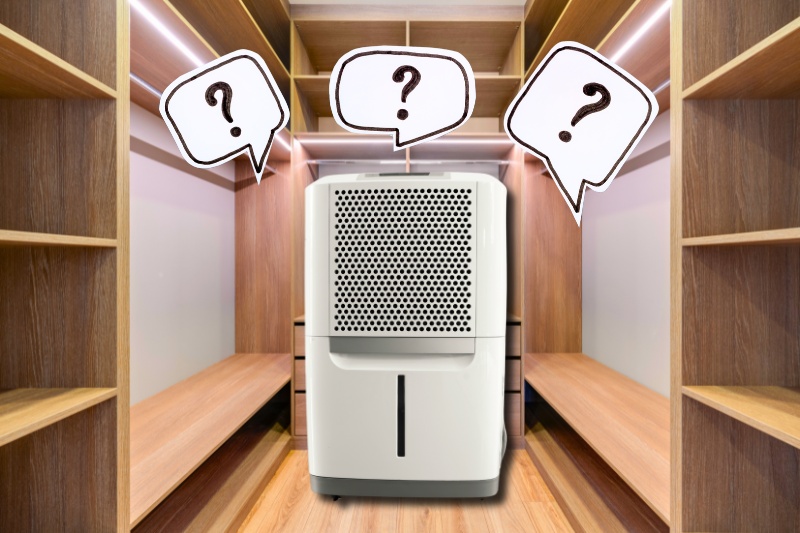Your wardrobe serves as a safe space for your clothes, but excess humidity can turn it into a breeding ground for mould, musty odours, and potential damage.
Dehumidifiers are a common way to tackle excess moisture in the home, but can you put a dehumidifier in a wardrobe?
The short answer is yes, you can put dehumidifiers in wardrobes. But – as with most things in life – it’s never that simple!
Join us as we explore the benefits, considerations, and practical tips for using a dehumidifier in your closet space, ensuring a dry environment for your clothing.
Can You Put a Dehumidifier in a Wardrobe?
Yes, you can put a dehumidifier unit in your wardrobe or closet. Wardrobes can be prone to excess humidity, especially in areas with high humidity or during certain seasons.
Using a dehumidifier in a closet is an excellent way to control humidity levels, preventing mould, mildew, and musty odours caused by these high moisture levels.
However, you need to consider the following things before placing the dehumidifier in your wardrobe:
1. Size of your wardrobe and dehumidifier
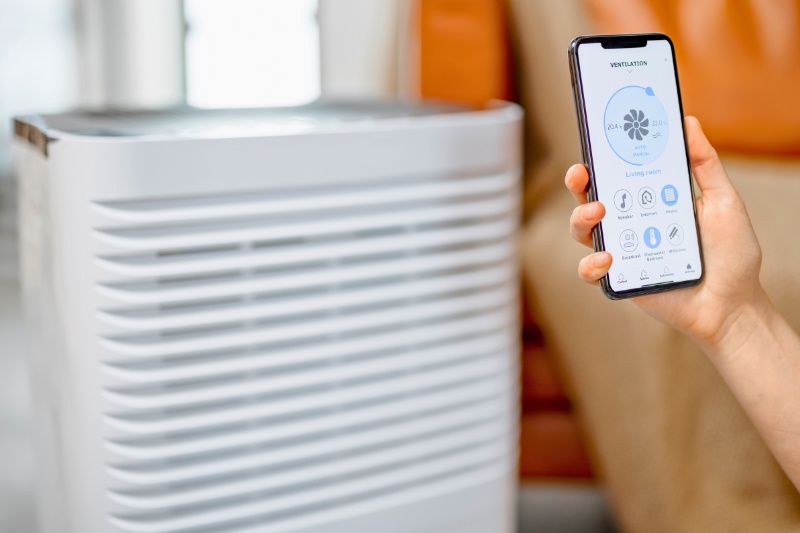
Dehumidifiers work by passing the air from the room that they’re in (or in this case, the wardrobe) over refrigerated coils.
Any moisture in the air condenses when it hits the coils, and all droplets of water are collected in a bucket beneath.
Choosing the right size dehumidifier is therefore crucial to its effectiveness. They need to be able to handle the volume of air in your wardrobe and have a big enough tank to collect all the water without frequent emptying. And this, of course, depends on the size of your closet.
A small 500 ml dehumidifier should be sufficient for almost all wardrobes.
On the other hand, large walk-in wardrobes or those with mould or damp patches are better suited to larger-capacity dehumidifiers.
2. Placement of the dehumidifier
If placing a dehumidifier in your wardrobe, it should be positioned in a central location. This helps distribute the dry air more evenly throughout the space, ensuring no damp and soggy corners are neglected.
You must also ensure that the air vents aren’t directly touching any items of clothing or are pushed up against walls and shelves of the wardrobe—the unit needs sufficient space around it for air intake and exhaust.
Also, avoid placing items directly in front of the dehumidifier, as this can obstruct airflow and reduce its effectiveness.
If you have a small wardrobe and a lot of clothes, it might not be possible to find a suitable location for a dehumidifier unit in your closet.
We suggest trying disposable wardrobe dehumidifiers instead or using our other tips for reducing wardrobe humidity (shown below).
3. Level of ventilation
Dehumidifiers can be used in both enclosed and open spaces. However, they are most effective at removing moisture from the air if the space is enclosed. This prevents moist air from entering the room at a faster rate than the unit can extract it.
Therefore, we only recommend putting a dehumidifier unit in your wardrobe if you can keep the door shut.
For this reason, you might want to purchase a cordless dehumidifier for your wardrobe. This removes the issue of having wires trailing from the wardrobe and propping the door open. Plus, you don’t need to worry about having a plug socket nearby.
Although possible, using a dehumidifier in open wardrobe systems won’t be as effective and isn’t recommended. You’re better off purchasing a larger-capacity dehumidifier for the bedroom that reduces the humidity in the wardrobe and the room at once.
Do Wardrobe Dehumidifiers Work?
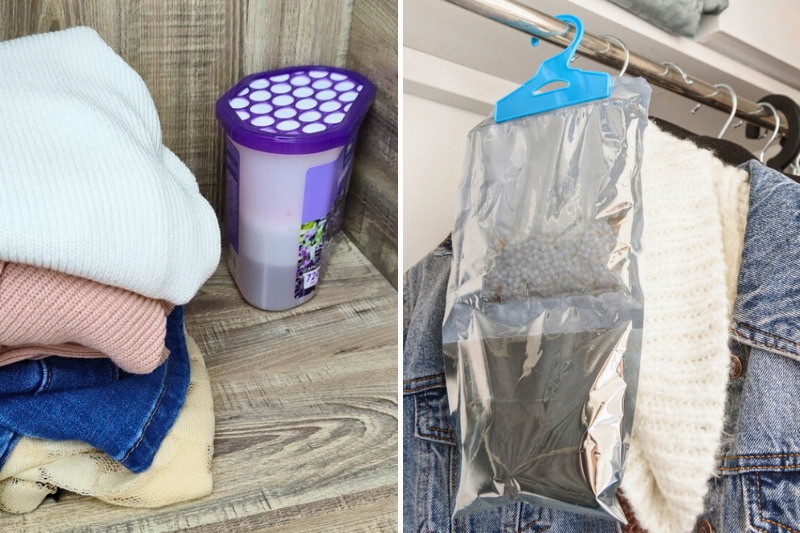
Assuming you have the correct size, placement, and ventilation, wardrobe dehumidifiers do work.
By using an appropriate dehumidifier in your closet, you can protect your clothes from moisture damage and ensure your wardrobe remains mould-free.
However, for it to be effective, you must perform:
- Regular check-ups: Periodically check the dehumidifier’s water tank and empty it as needed. If the tank needs emptying daily, you might want to consider getting a larger capacity unit to process more moisture.
- Regular maintenance: Regular maintenance is required for dehumidifiers. Mould and mildew can form on them, so the water collection bucket must be cleaned monthly. You will also need to replace filters annually and check things like the coils, as per the user manual.
Disposable hanging wardrobe dehumidifiers are also effective and require less maintenance. Rather than using refrigerated coils to condense water vapour, these disposable bags contain desiccants like silica or calcium chloride to absorb moisture from the air. Once the bag is full of water, discard it and replace it with a new one.
The downside of these bags is that they are disposable—not great for the environmentally conscious.
Also, while hanging wardrobe dehumidifiers do work, they struggle in high humidity. If you’re struggling with dampness or live in a humid country, an electronic dehumidifier will be more effective.
Do You Need a Wardrobe Dehumidifier?
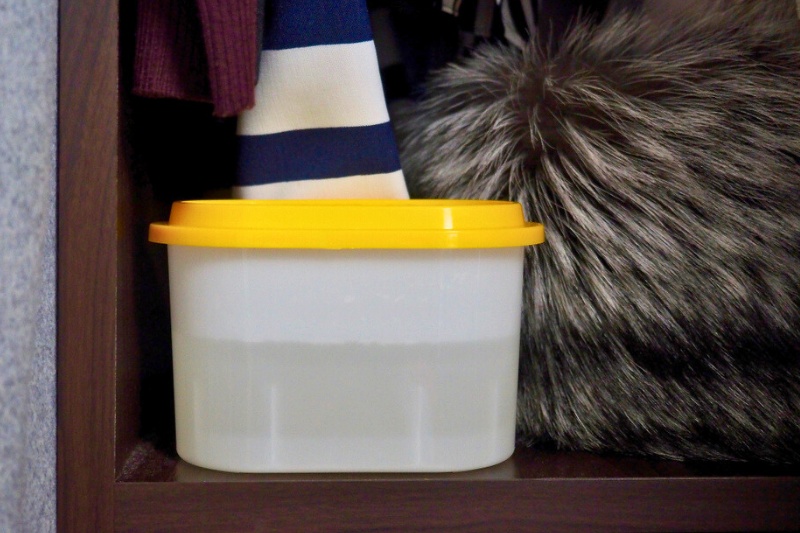
Determining whether you need a wardrobe dehumidifier depends on various factors. Before making a decision, assess the conditions in and around your wardrobe.
If you notice signs of excess moisture or have had issues in the past, a wardrobe dehumidifier could be a practical solution to help maintain your clothing and belongings.
Here are some other considerations to help you make a decision:
- Climate: If you live in an area with high humidity, a wardrobe dehumidifier can be extremely beneficial. High humidity levels can lead to mould growth, musty odours, and damage to clothing and other items in your wardrobe—all of which a dehumidifier can remove.
- Wardrobe location: Consider where your wardrobe is located and how much dampness it comes into contact with. For example, if it’s placed against an exterior wall that is prone to moisture, a dehumidifier could help prevent moisture-related issues.
- Type of clothing and materials: Certain fabrics, leather, and delicate materials are more susceptible to damage from excess moisture. If your wardrobe contains items made from these materials, a dehumidifier can help protect them from humidity-related deterioration.
- Past moisture issues: If you have experienced problems such as mould growth, mildew, or a musty smell from your clothes, it’s a sign that the space may benefit from a dehumidifier to address and prevent future issues.
- Room dehumidification: If the wardrobe is in a room where you already use a dehumidifier and the overall humidity levels in the room are under control, it may mitigate the need for a separate wardrobe dehumidifier.
What’s the Best Wardrobe Dehumidifier?
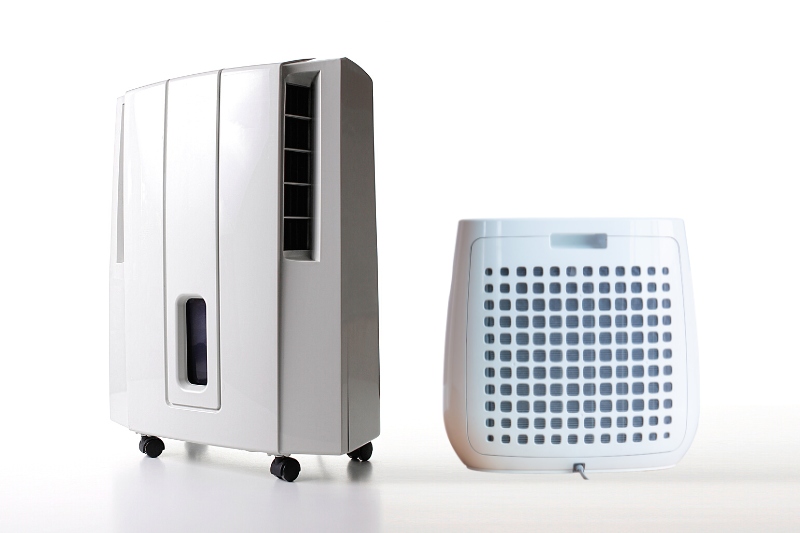
The best wardrobe dehumidifier depends on your preferences, but here are some factors that we think are important when choosing a model:
- Ensure that the dehumidifier has an appropriate capacity for the size of your wardrobe.
- Wardrobe dehumidifiers are often compact and designed to fit in smaller spaces. Choose one that fits well within your wardrobe without taking up too much space.
- Look for an energy-efficient model, especially if you plan to run the dehumidifier continuously. Energy-efficient units can save on electricity costs over time.
- Consider the noise level of the dehumidifier, especially if placed in a bedroom or other quiet areas. Look for dehumidifier models with quiet operation if noise is a concern.
- Choose a dehumidifier with features like auto-shutoff when the water tank is full and indicator lights to alert you when maintenance or emptying is required.
- Consider your budget, but remember that investing in a higher-quality dehumidifier can be more cost-effective than cheaper or disposable hanging dehumidifiers in the long run.
Based on this, our favourite dehumidifier for wardrobes is the Pro Breeze Mini Dehumidifier. It has a 500 mL capacity and compact design, which is suitable for most closets. But despite being small, it boasts many great features: It is cordless, ultra-quiet during operation, and has an auto shut-off function.
How Else Can You Reduce Humidity in a Wardrobe?
The most direct and effective way to reduce humidity is by using a dehumidifier. Choose a compact dehumidifier for small spaces and place it inside your wardrobe.
However, there are other options for reducing the amount of damp in your wardrobe:
1. Increase ventilation
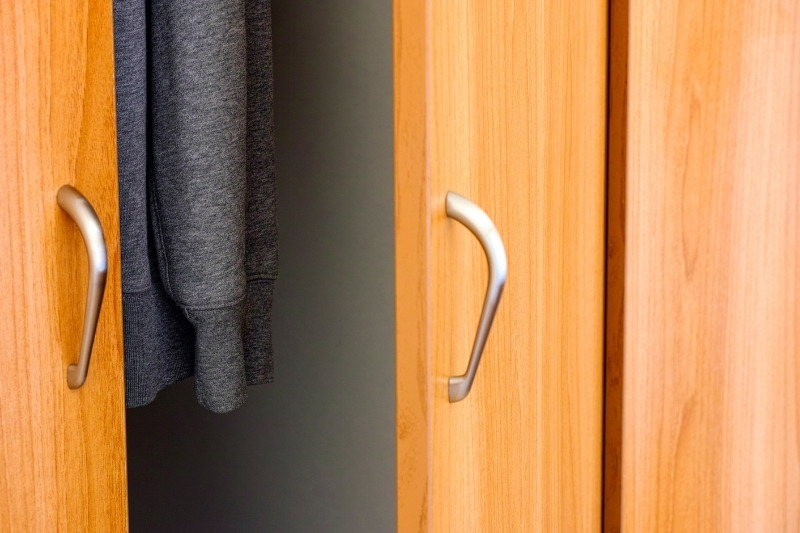
If you’re not using a dehumidifier, improve airflow within the wardrobe by keeping the doors partially open.
This allows for better air circulation and helps prevent stagnant air that can contribute to humidity buildup. If possible, consider adding ventilation holes or slats to the wardrobe doors.
2. Use desiccants or natural dehumidifiers
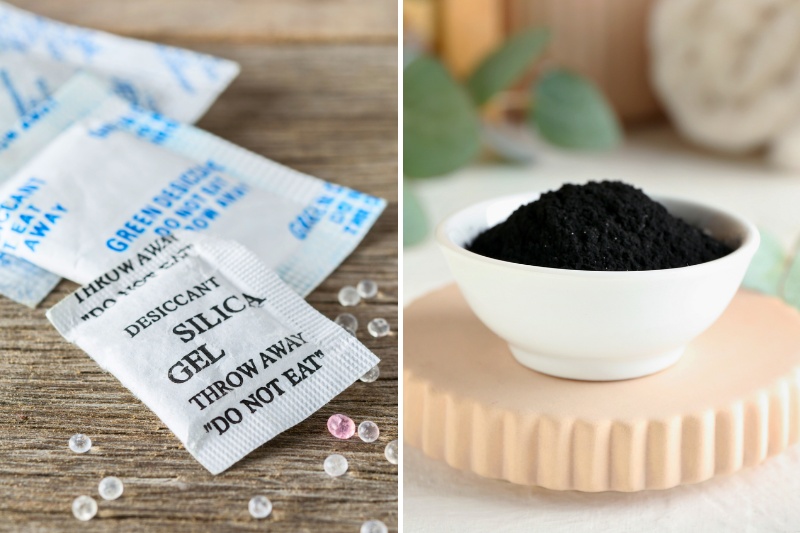
Small desiccant packets can absorb moisture from the air. Place desiccant packs inside your wardrobe or among your clothes to help control humidity and odours.
Alternatively, you can use natural dehumidifiers (like bamboo charcoal or activated charcoal bags) inside the wardrobe.
3. Remove damp or wet items

Wet or damp clothing can contribute to increased humidity, especially in a closed wardrobe space. Ensure that all items placed in the wardrobe are completely dry before storing them.
If you have damp clothing, consider speeding up the drying process using a hair dryer.
4. Store your clothes properly
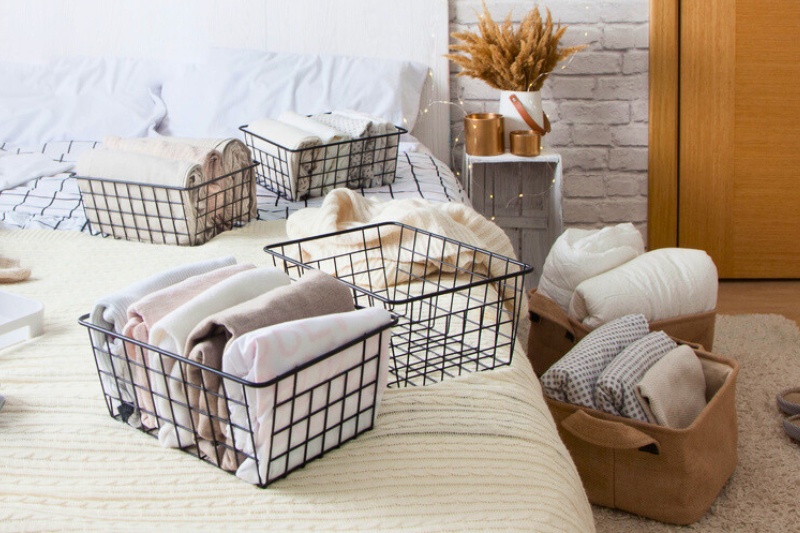
Tightly sealing clothes in plastic bags or containers can trap moisture and contribute to humidity.
Therefore, use breathable storage containers that allow air circulation around your clothes when putting them in your wardrobe. See our guide on how to store clothes for more tips.
5. Check for leaks or water intrusion
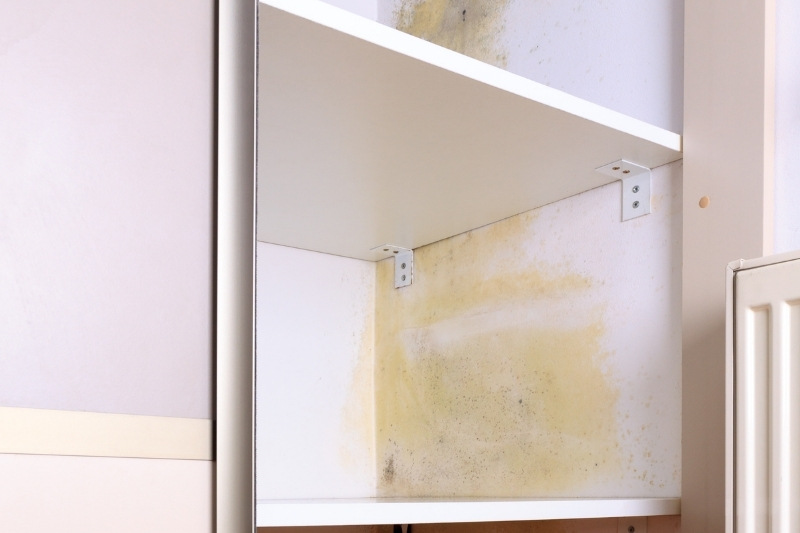
Inspect the area around your wardrobe for any signs of leaks or water intrusion, such as mould growth, condensation, or damp patches on walls and ceilings.
Addressing these issues promptly and removing any mould can prevent moisture from entering the room and your wardrobe.
6. Control room humidity
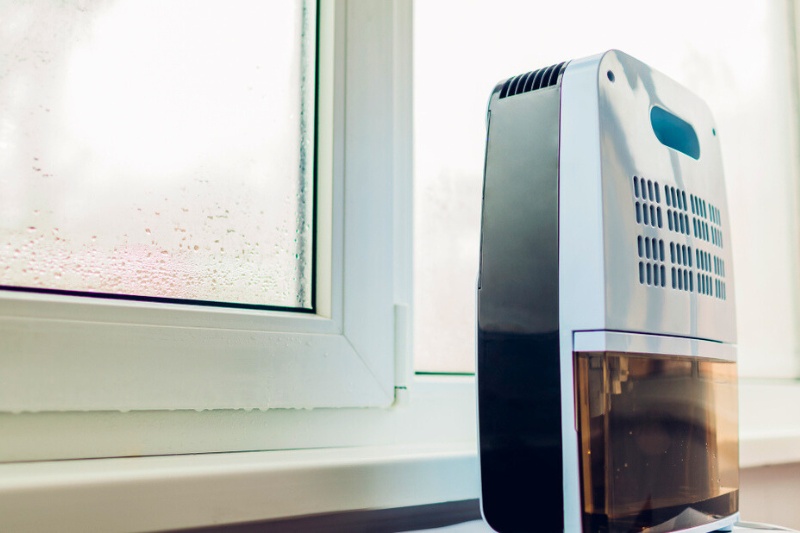
If you don’t want to put a dehumidifier in your wardrobe, use one in the room to control overall humidity levels.
Maintaining a lower humidity level in the entire room will benefit your wardrobe as well, especially if you have an open wardrobe or keep the door to your closet slightly ajar.
7. Regular cleaning and maintenance
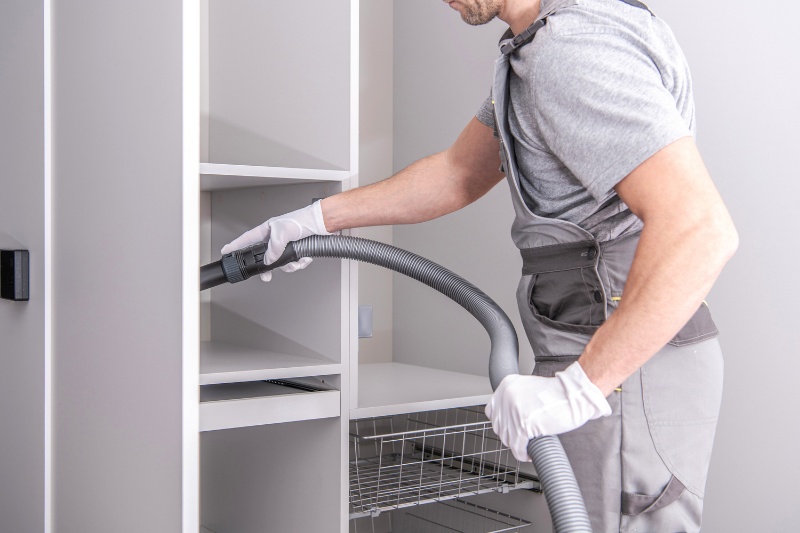
Keep the wardrobe clean and organised, as dust and dirt can trap moisture and contribute to humidity.
Regularly cleaning the interior and surfaces of your closet helps to prevent humidity and keeps your clothes smelling fresh, even when they’ve been in storage for a long time.

Hannah has a passion for cleaning. She worked her way around Australia by cleaning hostels in exchange for free accommodation and used her cleaning skills to bag a job as a chalet host for a luxury ski company in France.
